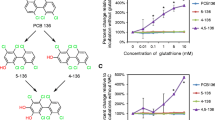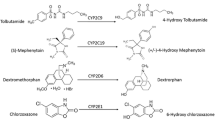Abstract
In order to assess the effects of bisphenol A (BPA) on enzymes of phase I and II biotransformation, studies were conducted in hepatic microsomes and precision-cut liver slices from male Sprague-Dawley rats. A testosterone hydroxylation assay was used for probing the activity of cytochrome P450 (CYP) forms, and an appropriate HPLC method for the separation of testosterone metabolites was developed. BPA markedly inhibited the hydroxylation of testosterone at 2α and 16α but not at 6β or 7α, suggesting a differential inhibition of some CYP forms, in particular CYP2C11. This inhibitory effect was also observed when slices were first exposed to BPA and then incubated with testosterone in the absence of BPA, indicative of an irreversible inhibition of CYP. In liver slices, a differential conjugation of hydroxylated testosterone metabolites was observed, which was significantly decreased in the presence of BPA. BPA also inhibited the conjugation of the model compound umbelliferone. Pretreatment with BPA did not affect the conjugation of testosterone and umbelliferone. No hydroxylation, but extensive conjugation of BPA was observed upon incubation of liver slices with BPA alone or with testosterone or umbelliferone. The rapid and preferred conjugation, however, does not prevent the irreversible inhibition of some CYP forms by BPA. In conclusion, this study has shown that BPA causes a selective and irreversible inhibition of certain CYP forms and interferes with the conjugation of other drugs.






Similar content being viewed by others
Abbreviations
- BPA :
-
Bisphenol A
- CYP :
-
Cytochrome P450
- DMSO :
-
Dimethylsulfoxide
- LDH :
-
Lactate dehydrogenase
- PCTS :
-
Precision-cut tissue slice
References
Bradford MM (1976) A rapid and sensitive method for the quantitation of microgram quantities of protein utilizing the principle of protein-dye binding. Anal Biochem 72:248–254
Elsby R, Maggs JL, Ashby J, Park B K (2001) Comparison of the modulatory effects of human and rat liver microsomal metabolism on the estrogenicity of bisphenol A: implications for extrapolation to humans. J Pharmacol Exp Ther 297:103–113
Fisher R, Smith PF, Sipes IG, Gandolfi AJ, Krumdieck CL, Brendel K (1990) Toxicity of chlorobenzenes in cultured rat liver slices. In Vitro Toxicol 3:181–194
Gonzales FJ (1990) Molecular genetics of the P-450 superfamily. Pharmacol Therap 45:1–38
Hanioka N, Jinno H, Nishimura T, Ando M (1998) Suppression of male-specific cytochrome P450 isoforms by bisphenol A in rat liver. Arch Toxicol 72:387–394
Hanioka N, Jinno H, Tanaka-Kagawa T, Nishimura T, Ando M (2000) Interaction of bisphenol A with rat hepatic cytochrome P450 enzymes. Chemosphere 41:973–978
Krishnan AV, Stathis P, Permuth SF, Tokes L, Feldman D (1993) Bisphenol-A: an estrogenic substance is released from polycarbonate flasks during autoclaving. Endocrinology 132:2279–2286
Lake BG (1987) Preparation and characterization of microsomal fractions for studies on xenobiotic metabolism. In: Snell K, Mullock B (eds) Biochemical toxicology. IRL Press, Oxford, pp 183–215
Markey CM, Michaelson CL, Sonnenschein C, Soto AM (2001) Alkylphenols and bisphenol A as environmental estrogens. In: Metzler M (ed) Endocrine disruptors, Part I. Springer, Berlin Heidelberg New York, pp 129–153
Niwa T, Tsutsui M, Kishimoto K Yabusaki Y, Ishibashi F, Katagiri M (2000) Inhibition of drug-metabolizing enzyme activity in human hepatic cytochrome P450 s by bisphenol A. Biol Pharm Bull 23:498–501
Omura T, Sato R (1964) The carbon monoxide-binding pigment of liver microsomes: I. Evidence for its hemoprotein nature. J Biol Chem 239:2370–2377
Parrish AR, Gandolfi AJ, Brendel K (1995) Precision-cut tissue slices: applications in pharmacology and toxicology. Life Sci 57:1887–1901
Pfeiffer E, Metzler M (1998) In vitro metabolism of bisphenol-A. Toxicologist 42:279
Pfeiffer E, Rosenberg B, Deuschel S, Metzler M (1997) Interference with microtubules and induction of micronuclei in vitro by various bisphenols. Mutat Res 390:21–31
Pottenger LH, Domoradzki JY, Markham DA, Hansen SC, Cagen SZ, Waechter JM Jr (2000) The relative bioavailability and metabolism of bisphenol A in rats is dependent upon the route of administration. Toxicol Sci 54:3–18
Reid EE, Wilson E (1944) The relation of estrogenic activity to structure in some 4,4’- dihydroxydiphenylmethanes. J Am Chem Soc 66:967–969
Ryan DE, Levin W (1990) Purification and characterization of hepatic microsomal cytochrome P-450. Pharmacol Ther 45:153–239
Schenkman JB, Thummel KE, Favreau LV (1989) Physiological and pathophysiological alterations in rat hepatic cytochrome P-450. Drug Metab Rev 20:557–584
Snyder RW, Maness SC, Gaido KW, Welsch F, Sumner SC, Fennell TR (2000) Metabolism and disposition of bisphenol A in female rats. Toxicol Appl Pharmacol 168:225–234
Soucek P, Gut I (1992) Cytochromes P-450 in rats: structures, functions, properties and relevant human forms. Xenobiotica 22:83–103
Staples CA, Dorn PB, Klecka GM, O’Block ST, Harris LR (1998) A review of the environmental fate, effects, and exposures of bisphenol A. Chemosphere 36:2149–2173
Tsutsui T, Tamura Y, Suzuki A, Hirose Y, Kobayashi M, Nishimura H, Metzler M, Barrett JC (2000) Mammalian cell transformation and aneuploidy induced by five bisphenols. Int J Cancer 86:151–154
Waxman DJ (1988) Interactions of hepatic cytochromes P-450 with steroid hormones. Regioselectivity and stereospecificity of steroid metabolism and hormonal regulation of rat P-450 enzyme expression. Biochem Pharmacol 37:71–84
Acknowledgements
The research reported in this study complies with the current laws of Germany, where the experiments were carried out.
Author information
Authors and Affiliations
Corresponding author
Rights and permissions
About this article
Cite this article
Pfeiffer, E., Metzler, M. Effect of bisphenol A on drug metabolising enzymes in rat hepatic microsomes and precision-cut rat liver slices. Arch Toxicol 78, 369–377 (2004). https://doi.org/10.1007/s00204-004-0543-6
Received:
Accepted:
Published:
Issue Date:
DOI: https://doi.org/10.1007/s00204-004-0543-6




